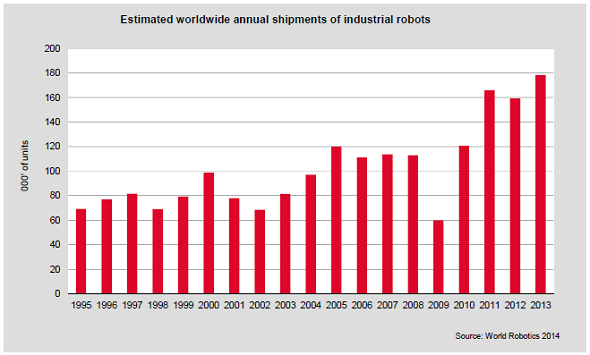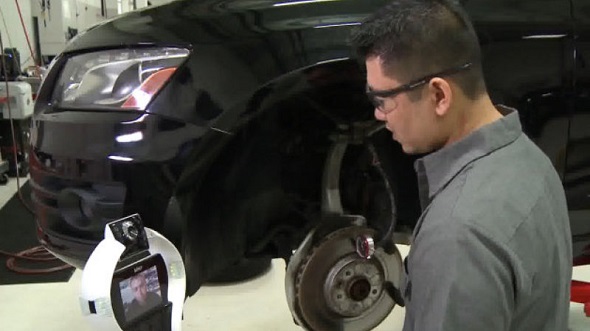With more old cars on the road than ever before and with new ones sporting elaborate powertrains run by onboard computers, it makes sense that many dealerships rely upon their service department to drive profits.
And to know where things may be headed in your repair bays, we might take a look at how the cars are put together in the first place:
Terminator with a Propeller Cap
Auto manufacturing comprises the largest market for industrial robots, and among all industries – including electronics – it is by far the most advanced.
Back in the 1970s when a quarter of American workers manufactured things, industrial robots were little more than science fiction.
By 2010 they had become must-have equipment for modern manufacturers, and only one in ten American workers still worked in manufacturing. Exporting jobs played a significant role, of course, but manufacturing employment is declining all over the world today, including in China, and automation is a major reason.
In fact, Terry Gou, the CEO of Foxconn, the million-employee Chinese manufacturer that assembles, among other things, Apple’s iPhones, justified his plan to vastly expand his use of robots by explaining, somewhat inelegantly, that, “as human beings are also animals, to manage one million animals gives me a headache.”
While that may account for some of the demand for industrial robots, many auto plant managers are more interested in the positive feedback loop robotic manufacturing has already created with the market. Today’s buyer expects an extremely reliable vehicle built to very small tolerances – something only robots can do repetitively.
Today’s assembly line matches the sophistication of the cars being assembled. In fact, the auto industry globally spends more on research and development than any other industry save electronics and healthcare.
One result: A car's computer contains more lines of code than that of a Boeing 747 or the Facebook website. A decade ago electronics and software made up twenty percent of a car’s cost; today it’s thirty-five percent.
And to understand where this is all going, it’s worth noting that Tesla’s latest software upgrade – delivered free and wirelessly to all its cars – enhanced the car’s acceleration and it’s traction in snow, two things one might not intuitively associate with software.
So if Kyle Reese came back from the future to rescue your mechanics instead of his mother, what would he tell them?
Terminator with a Swiss Watch
We may get a clue from the noble tradition of Swiss watchmakers.
They say that when you are tested to become a master watchmaker, you do not prove your worthiness by making a watch. Instead, you prove it by making all the tools required to make a watch, suggesting that mastery over the tools reveals a deeper understanding of watch-making than actual watch-making.
For some, seeing a robot flip a part weighing hundreds of pounds into perfect alignment or seeing one paint while enveloped in toxic mist might call to mind the replaced human laborers.
But given that machines are obviously better suited for brutal or poisonous tasks, we might choose to call to mind the remarkable opportunity for job growth presented by the robotics industry itself -- and by extension, the evolving role for humans in the auto industry overall.

You can see a pretty clear trend in the chart above; as of 2013, when sales jumped 12% and topped $9.5 billion, the world population of working industrial robots stood at around 1.6 million. Analysts expect that to hit two million by 2017. For every ten thousand employees in the auto industry, there are over 1,500 robots.
Unfortunately the Bureau of Labor Statistics doesn’t have a separate category for robot technicians; they’re lumped into the “Industrial Machinery Mechanics and Maintenance Workers and Millwrights” category, but the BLS sees robust growth in demand for these workers, who earn a median salary around $45,000. The International Federation of Robotics forecasts that the industry will generate up to three million new jobs by 2020.
Terminator with a Human Face
So if Kyle told your mechanics that, on the manufacturing side, learning how to service the tools that build the cars is becoming more important than learning how to build the car itself, how would that translate to your service department?
In the short term, it may be best to plan for ever-more sophisticated diagnostic tools. In fact, analysts predict that the market for these tools will exceed $3.7 billion by 2018 when it will be growing at a rate of over 5%.
And while they won’t actually do any labor, they will require ever-more sophisticated operators who can understand and act upon the diagnostics quickly and with confidence.
If diagnostic tools represent the first similarity between today’s manufacturing line and your service bay, Audi may have taken the next step with its new “telepresence” robot.

Equipped with multiple cameras and the ability to follow its human counterpart, the “robot” connects the mechanic with a specialist so they can work on a repair together.
The step after that may be robots that can work alongside your crew doing, as usual, anything brutal or toxic while your humans do everything requiring intelligence and judgment.
Terminator with an Indecipherable Gleam in His Eyes
Needless to say this will change your service department cost analysis, and in the coming years auto dealership owners and managers may need to make some pretty bold guesses as to which tools will generate the best return.
Most likely each dealership will hit upon a different solution, but whatever solution you develop you know that the only way to get that return is to book revenue first.
As you put more capital into your service department, make sure to optimize your ability to sell services to your customer. They may well come to expect an even higher level technical excellence in the same way they expect cars built to standards only robot-assisted manufacturing can accomplish.
And they will expect you to accommodate their preferred payment method, which, for one out of five Americans making a purchase of over $100, means paying with a check. Be sure you can deposit it right from your office with a guarantee that you will receive the revenue, and also be sure you can offer payment plans that do not require financing. Click the link below to learn more.
And should you wonder why the Terminator has that odd look on his face, and what might happen after all the assembly line laborers become robot technicians, you might contemplate this video, where you can watch the space station’s robot fixing itself:




